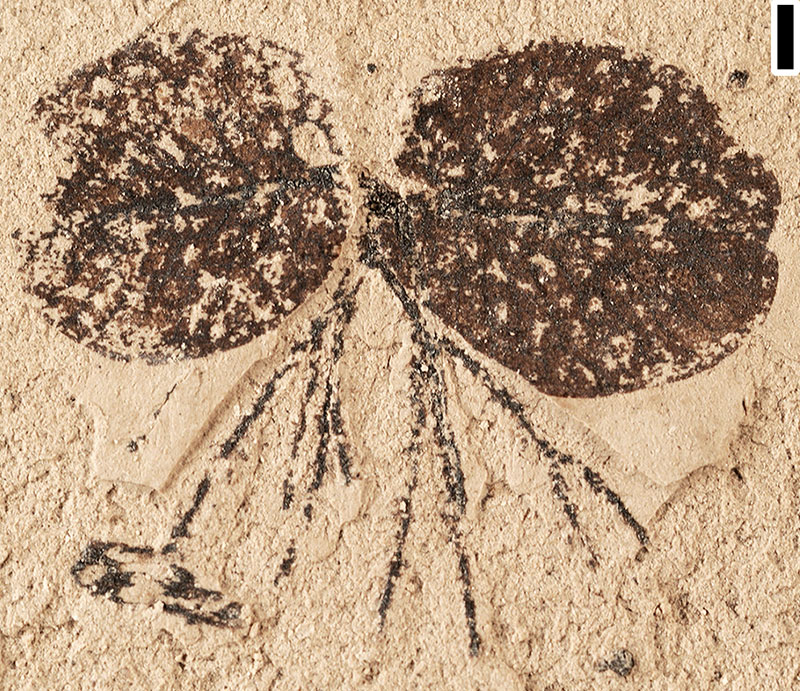FIGURE 1. Locations of the Bovay clay pit (UF15737) in Marshall County, and Bolden clay pit (UF15738) in Benton County, northern Mississippi, USA.

FIGURE 2. Sketch map showing collection sites in the Bovay clay pit and the Bolden clay pit, northern Mississippi: 1) Bovay clay pit. Numbers indicate collecting sites within the clay pit; 2) Bolden clay pit. * indicates the place where the section is measured in Johnston (1993, p. 73, text-figure 2).

FIGURE 3. Simplified stratigraphic column of the middle Eocene Claiborne Group in northern Mississippi (after Dockery, 1996). Specimens examined in this paper were collected from the Tallahatta Formation at Bovay and Bolden localities, Mississippi. Specimens from other localities used for comparison to the Tallahatta Formation, including the Warman clay pit, were collected from the Cockfield Formation in western Tennessee and southwest Kentucky.

FIGURE 4. Anonaspermum robertsi (Berry) Wang, Blanchard, and Dilcher: 1-2) UF15738-060635. Part and counterpart of a specimen showing reniform seed, transverse endosperm ruminations, and thick testa. Scale bar equals 3 mm.

FIGURE 5. Protomimosoidea buchananensis Crepet and Taylor, 1986, UF15737-026430. Flower showing at least three valvate petals, 10 stamens, and dorsifixed anthers. Note two stamens with missing anthers (indicated by arrows). Scale bar equals 0.5 mm.

FIGURE 6. Protomimosoidea buchananensis Crepet and Taylor, 1986, UF15737-060709. Specimen showing three petals and five stamens. Scale bar equals 0.5 mm.

FIGURE 7. Protomimosoidea buchananensis Crepet and Taylor, 1986: 1) UF15737-027593. Two flowers with attached anthers. Note long pedicel. Scale bar equals 2 mm; 2) Enlargement of Figure 7.1 (indicated by upper arrow) to show anther. Scale bar equals 1 mm; 3) Enlargement of Figure 7.1 (indicated by left arrow) to show anthers and filaments. Scale bar equals 1 mm.

FIGURE 8. cf. Acrocarpus sp.: 1-2) UF15737-008276, 008276'. Part and counterpart of a specimen showing a single valve of a fruit with alternating outlines of three seeds (s) and four seed chambers (sc). Scale bar equals 5 mm.

FIGURE 9. cf. Gleditsia? mississippiensis Berry, 1916b: 1-2) UF15738-008791, 008791'. Part and counterpart of a specimen showing stipe (s), calyx (c), calyx lobes (cl), and pod with rounded apex. Scale bar equals 2 mm.

FIGURE 10. "Short, broad winged fruit" (1-3) UF15737-008279: 1) Showing stipe (s), calyx (c), and pod with attenuate apex (a). Scale bar equals 5 mm; 2) Counterpart of UF15737-008279. Scale bar equals 5 mm; 3) Enlargement of Figure 10.2 to show valve venation. Scale bar equals 2 mm; 4) UF15738-008790. Showing stipe (s), calyx (c), and pod with attenuate apex (a). Scale bar equals 5 mm.

FIGURE 11. Claiborne Fabaceae Floral Type 1, UF15737-059328. Laterally preserved flower showing a short pedicel (pd), calyx (c), 2 petals (pt), standard petal (sp), expanding ovary (o) with an apical style (st), and a stamen with a filament (f) and an anther (a). Scale bar equals 2 mm.

FIGURE 12. Claiborne Fabaceae Floral Type 2: 1-2) UF15738-008215, 008215'. Part and counterpart of a laterally preserved flower showing style (s) and a pedicel (p). Scale bars equal 2 mm; 3) Enlargement of Figure 12.2 to show anthers (a), filaments (f), and calyx (c). Scale bar equals 1 mm; 4-5) UF15737-059312, 059312'. Part and counterpart of a laterally preserved flower showing a petal (indicated by arrows) and stamens above. Scale bar equals 2 mm; 6) UF15737-059252. A laterally compressed, immature flower showing a style (s). Scale bar equals 2 mm.

FIGURE 13. cf. Populus sp., UF15738-008213. Specimen showing a four-valved capsule. Scale bar equals 1 mm.

FIGURE 14. cf. Trigonobalanoidea americana Crepet and Nixon, 1989: 1) UF15737-059224. An immature infructescence with at least 32 sessile fruits. Scale bar equals 2 mm; 2) Enlargement of a fruit indicated by the upper arrow in Figure 14.1 to show two styles (s, indicated by arrow). Scale bar equals 0.5 mm; 3) Enlargement of a fruit indicated by the lower arrow in Figure 14.1 to show three styles (s, indicated by arrow). Scale bar equals 0.5 mm; 4) Counterpart of Figure 14.1 showing an immature infructescence. Scale bar equals 2 mm.

FIGURE 15. Claiborne Fagaceae Fruit Type 3 (1-3): 1) UF15815-005347', Lamkin clay pit, Kentucky. Fruit showing two nutlets (n) and spiny cupule valve (c) with a web-like pattern. Scale bar equals 2 mm; 2) UF15815-005347, Lamkin clay pit, Kentucky. Counterpart of Figure 15.1 showing a short peduncle (p). Note the overlap of spiny cupule valves (c). Scale bar equals 2 mm. 3) UF15826-051307, Warman clay pit, Tennessee. Fruit showing spiny cupule valve (c) and short peduncle (p). Scale bar equals 2 mm. Catahoulea grahamii DeVore, Pigg, Dilcher and Freile, 2014: 4) UF15841-062191, Huntsville, Texas. Fruit showing spiny cupule valve (c) and long peduncle (p). Scale bar equals 2 mm. Claiborne Fagaceae Fruit Type 5 (5) UF15826-29216, Warman clay pit, Tennessee. Specimen showing peduncle (p) and two overlapping spiny cupule valves (c). Scale bar equals 2 mm.

FIGURE 16. Claiborne Fagaceae Fruit Type 4: 1) UF15737-059211. Showing interwined spines, fruit body, a short peduncle (p). Scale bar equals 1 mm; 2) UF15737-059211'. Counterpart of Figure 16.1 showing three ridges converging at both ends of the fruit body and a short peduncle (p). Scale bar equals 1 mm.

FIGURE 17. “Solanites” pusillus Berry, 1930: 1) UF15737-049568. Vertically compressed flower showing five triangular sepals (s) alternating with petals (p, only three are visible), and a floral cup at the center. Scale bar equals 1 mm; 2) UF15737-049568'. Counterpart of Figure 17.1 showing sepals and membranaceous petals with conspicuous venation. Scale bar equals 1 mm; 3) UF15737-008226. A laterally compressed flower showing an obtriangular hypanthium with an inferior ovary (o), a short pedicel (indicated by arrow), and three sepals (s), and three petals (p). Scale bar equals 1 mm; 4) UF15737-049566. Vertically compressed flower showing a circular floral cup (dark concentric rings) and five triangular sepals alternating with five petals. Scale bar equals 1 mm; 5) UF15737-049566'. Counterpart of Figure 17.4 showing sepals alternating with petals, and a floral cup with radiating veins. Note the center hole resulting from vertical compression of the pedicel. Scale bar equals 1 mm; 6) Enlargement of Figure 17.2 to show venation of sepal (s) and petal (p). Scale bar equals 0.5 mm.

FIGURE 18. “Solanites” pusillus Berry, 1930: 1) UF15738-008214. Vertically compressed flower showing four sepals. Note two filaments (f) between two adjacent sepals (s) indicated by arrows. Scale bar equals 1 mm; 2) UF15738-008214'. Counterpart of Figure 18.1 showing five sepals and the radiating veins on the hypanthium extending to the sepals (indicated by arrow). Scale bar equals 1 mm.

FIGURE 19. Bridgesia bovayensis Manchester and O’Leary, 2010: 1) UF15737-30660. Fruit showing pedicel, hypogynous perianth scar (ps), stylar protrusion (sp), and two mericarps each with a large darkened locular area. Scale bar equals 3 mm; 2) UF15737-30661. Mericarp showing reticulate veins on the wing and locular area. Scale bar equals 3 mm.

FIGURE 20. Gordonia warmanensis Grote and Dilcher, 1992: 1-2) UF15737-059235, 059235'. Part and counterpart of a specimen showing a winged seed. Note slightly concave ventral margin and convex dorsal margin. Scale bar equals 1 mm; 3-4) UF15737-059239, 059239 '. Part and counterpart of a specimen showing slightly concave ventral margin and convex dorsal margin. Scale bar equals 1 mm.

FIGURE 21. cf. Natsiatum wilcoxiana (Berry) Stull et al., 2011: 1-2) UF15737-059325, 059325'. Part and counterpart of a specimen showing irregular, blindly ending ridges. Scale bar equals 1 mm.

FIGURE 22. Eucommia eocenica (Berry) Brown, 1940: 1) UF15737-008218. Fruit showing apical stigmatic cleft (sc), fertile carpel (fc) bearing a conspicuous reticulum (r) composed of fascicles of vascular strands, infertile carpel (ic), and carpel suture (cs). Scale bar equals 2 mm; 2, 3) UF15737-011033, 011033’. Part and counterpart of a specimen showing stout stipe (s). Scale bar equals 3 mm; 4) UF15737-011032 - Incomplete fruit showing longer stipe. Scale bar equals 2 mm; 5) UF15737-011063. Well developed fruit showing vascular strands of the reticulum and stout stipe. Scale bar equals 2 mm; 6) UF15737-011035. Distal half of fruit showing compression of latex strands and strong carpel suture. Scale bar equals 2 mm; 7) UF15738-011027. Fruit showing stout stipe. Scale bar equals 3 mm; 8-9) UF15737-011022, 011022’. Fruit showing impression of reticulum, and compression of vascular and latex strands. Scale bar equals 3 mm; 10) UF15737-008219. Fruit showing well developed fertile carpel on the right and infertile carpel on the left. Scale bar equals 3 mm; 11) UF15737-011065. Fruit showing a complete stipe. Scale bar equals 3 mm. 12-13) UF15738-011030a, 011030'a. Part and counterpart of a specimen showing two fruits. Note stigmatic cleft (sc). Scale bar equals 3 mm; 14-15) UF15738-0052526, 0252526'. Part and counterpart of a specimen showing stigmatic cleft, reticulum, and stipe. Scale bar equals 3 mm; 16-17) UF15738-011028, 011028'. Fruit showing short stipe. Scale bar equals 3 mm.

FIGURE 23. Dipelta bovayensis sp. nov.: 1-2) UF15737-049026, 049026'. Part and counterpart of a specimen showing a fruit with two overlapping bracts (indicated by arrow), venation, and a slender pedicel. Note obtuse apex of the top bract. Scale bar equals 3 mm; 3) Enlargement of Figure 23.1 to show reticulate venation. Scale bar equals 3 mm.

FIGURE 24. Paleopanax boldensis sp. nov.: 1) UF15738-059493. Showing one central acrocidal capsule flanked by two lateral, younger capsules and a long peduncle. Note dehiscence scar of the capsule (indicated by white arrow). Scale bar equals 2 mm; 2) Enlargment of Figure 24.1 (indicated by black arrow) to show persistent apical style. Scale bar equals 1 mm; 3) UF15738-059493'. Counterpart of Figure 24.1 showing persistent style and dehiscence gap (indicated by arrow. Scale bar equals 2 mm; 4) Enlargement of Figure 24.3 to show the three branches of the style. Scale bar equals 1 mm.

FIGURE 25. “Solanites” saportanus (Berry) Martínez-Millán, 2010: 1) UF15737-008222. Vertically compressed flower showing six perianth parts and pedicel (indicated by arrow). Note that each perianth part has a midvein and two or three faint lateral veins. Scale bar equals 1 mm; 2) UF15737-008222’. Counterpart of Figure 25.1 showing bases of six perianth parts. Scale bar equals 1 mm.

FIGURE 26. “Solanites” sarachaformis Berry, 1930: 1) UF15737-049569. Vertically preserved flower showing four floral parts each with four or five converging veins and pedicel (indicated by arrow). Scale bar equals 1 mm; 2) UF15737-049569’. Counterpart of Figure 26.1 showing a shallow floral cup formed by fusion of basal portions of the four floral parts. Note relatively strong veins extend to the center of the cup. Scale bar equals 1 mm.

FIGURE 27. Claiborne Floral Type 5: 1-2) UF15738-008216, 008216'. Part and counterpart of a specimen showing five perianth parts and an ovary. Scale bar equals 2 mm.

FIGURE 28. Claiborne Floral Type 7. UF15737-059208a. A flower showing three sepals (s), three petals (p), and an ovary (indicated by arrow). Scale bar equals 1 mm.

FIGURE 29. Claiborne Floral Type 8: 1) UF15737-049570. Specimen showing seven floral parts (indicated clockwise by numbers) and a pedicel (indicated by arrow). The eighth floral part is proably positioned between 6 and 7. Scale bar equals 2 mm; 2) UF15737-049570'. Counterpart of Figure 29.1 showing two filaments (f) and the hypanthium rim (indicated by arrow). Scale bar equals 2 mm; 3) UF15737-049567a. Flower showing three floral parts of different sizes and five filaments attached to the hypanthium rim (indicated by arrow). Scale bar equals 2 mm; 4) Enlargement of Figure 29.3 to show attachment of filaments. Scale bar equals 0.5 mm.

FIGURE 30. Claiborne Floral Type 9: 1) UF15737-059240. Flower showing five floral parts, floral rim (r), and pedicel (p). Scale bar equals 1 mm; 2) UF15737-059240'. Counterpart of Figure 30.1 showing two filaments (indicated by arrow) and impression of an ovary rim defined by two dark concentric rings with the pedicel impression at the center. Scale bar equals 1 mm; 3) UF15737-059247. Flower showing several filaments attached to the floral rim (arrow). Scale bar equals 1 mm.
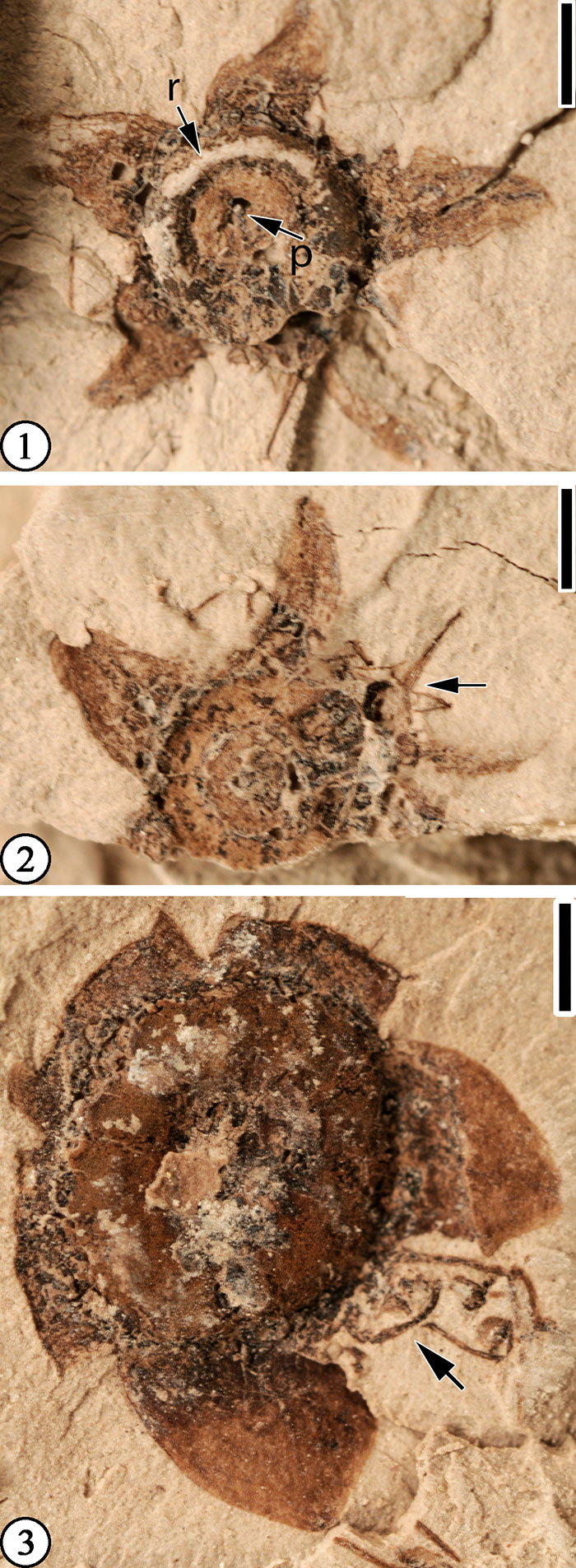
FIGURE 31. Claiborne Floral Type 10. UF15737-059243b. Vertically preserved flower showing six perianth parts, ovary (dark area), and pedicel (indicated by arrow on the right). The sixth perianth part is indicated by the arrow on the left. Scale bar equals 1 mm.

FIGURE 32. Claiborne Floral Type 11 (1-2), UF15737-008227, 008227’. Part and counterpart of a specimen showing a flower with three floral parts and a long pedicel. Arrows point to the gap between two adjacent floral parts, indicating the possible presence of the fourth floral part. Scale bar equals 1 mm.
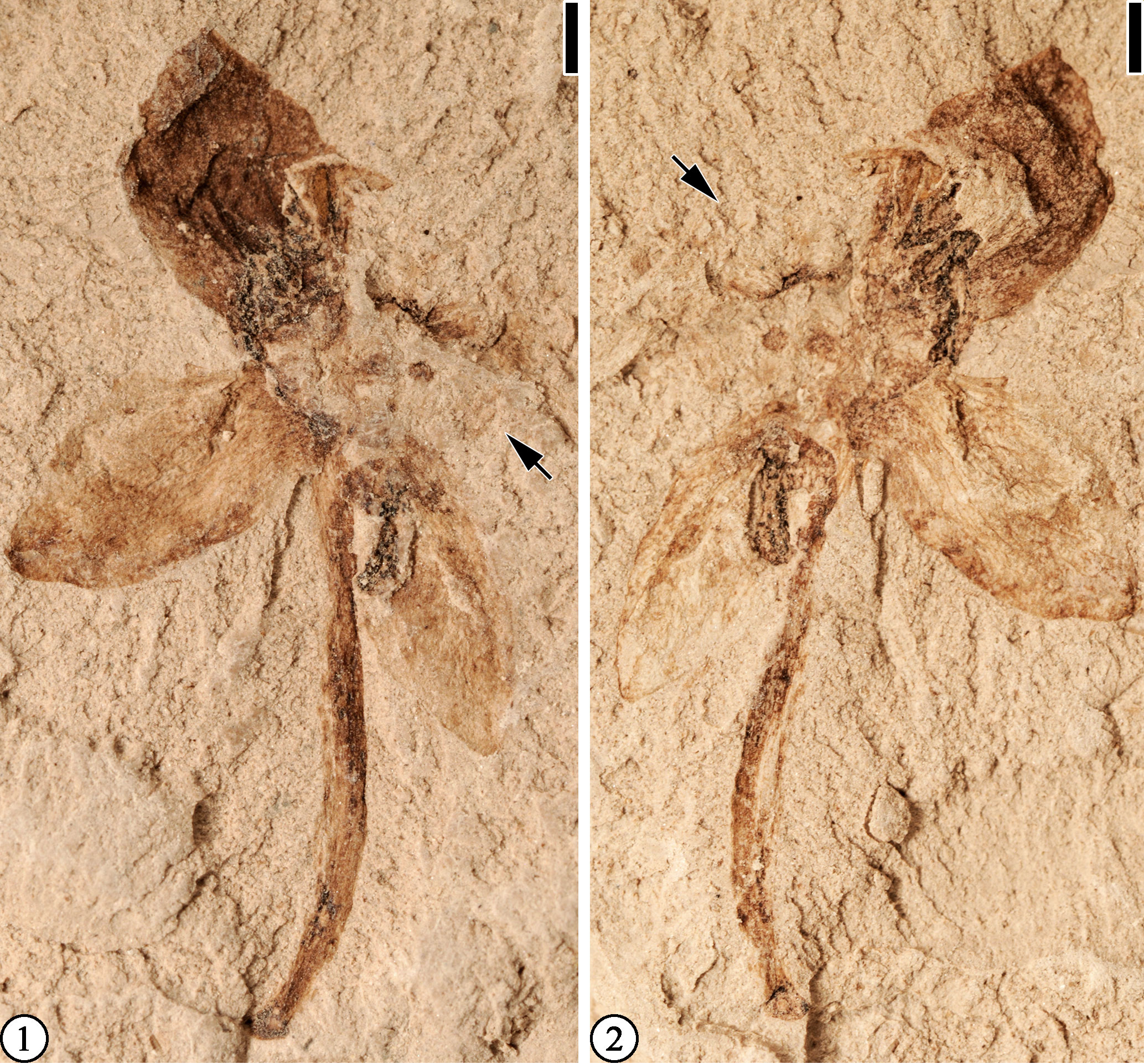
FIGURE 33. Claiborne Floral Type 12: 1-2) UF15738-008217, 008217'. Part and counterpart of a specimen showing a cluster of vertically and laterally compressed flowers subtended by two large bracts or leaves. Scale bar equals 5 mm; 3) Enlargement of Figure 33.2 (indicated by arrow) to show flowers. Scale bar equals 2 mm.

FIGURE 34. Claiborne Floral Type 13: 1-2) UF15737-059232, 059232'. Part and counterpart of a specimen showing dispersed, laterally compressed flowers. Scale bar equals 1 mm; 3) Enlargement of Figure 34.2 to show pedicel (pe), ovary (o), perianth (p), and styple (s) of the flower. Scale bar equals 0.5 mm.
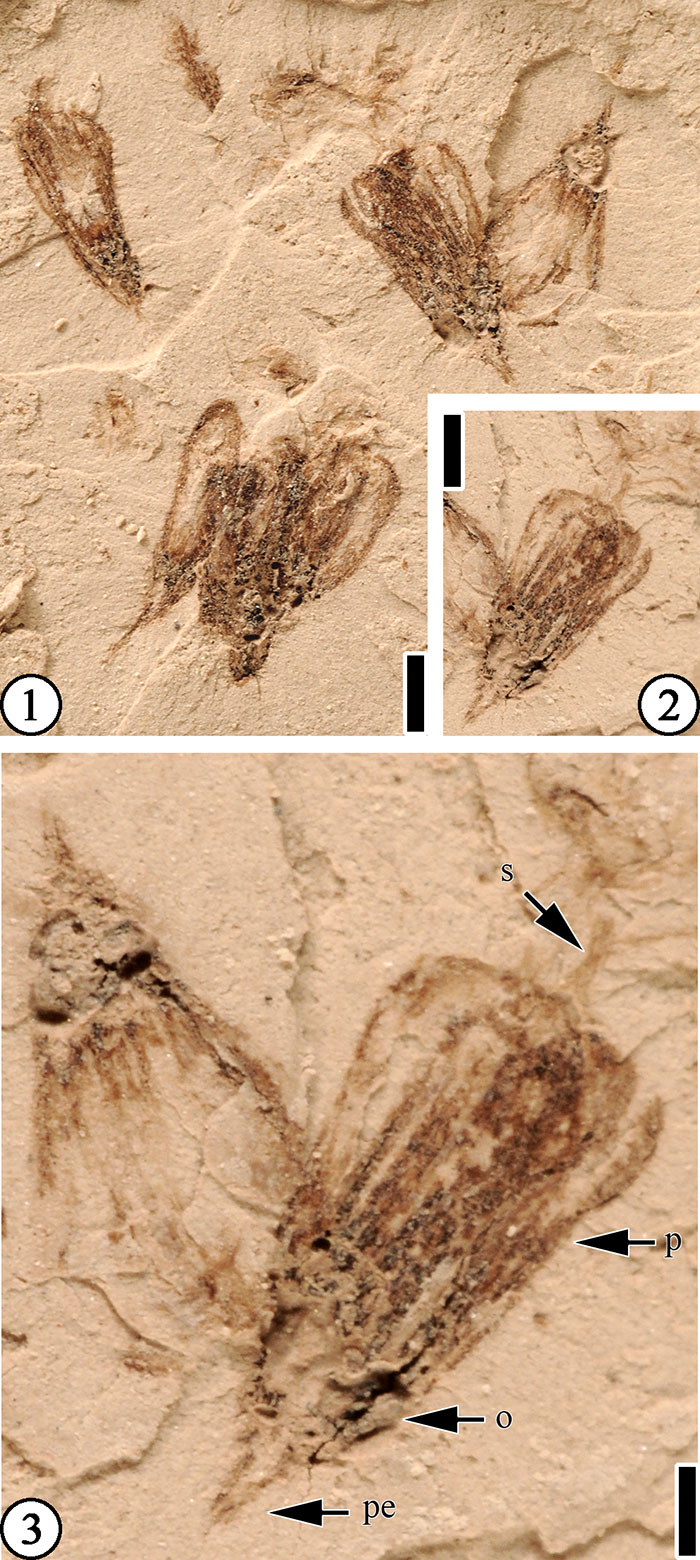
FIGURE 35. Claiborne Floral Type 14, UF15738-052528. Showing sympetalous, small flower with a cupuliform perianth tube. Note three perianth lobes and remnant of calyx (c). Scale bar equals 1 mm.
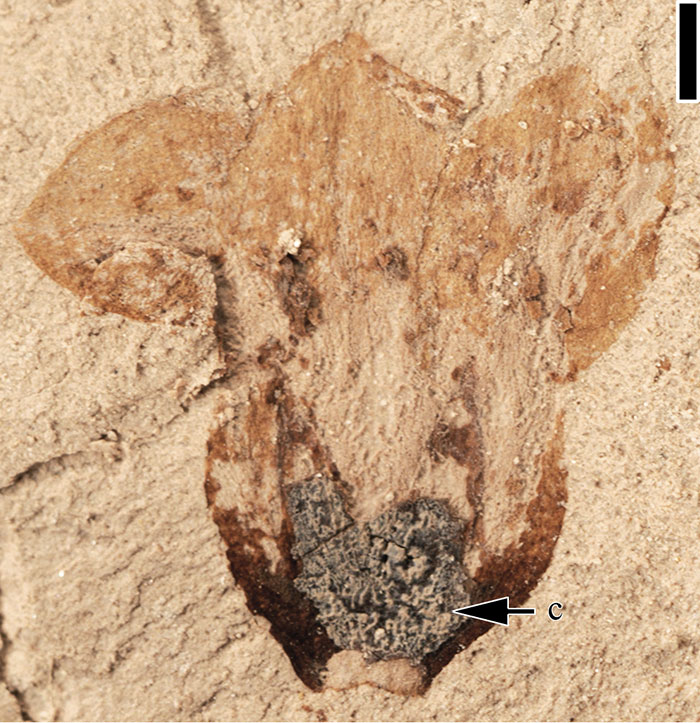
FIGURE 36. Claiborne Floral Type 15: 1) UF15737-059251. Laterally preserved flower showing three separate perianth parts above and a receptacle (indicated by arrow). Scale bar equals 0.5 mm; 2) UF15737-059251'. Counterpart of Figure 36.1 showing a receptacle (r) and a pedicel (p). Scale bar equals 0.5 mm.
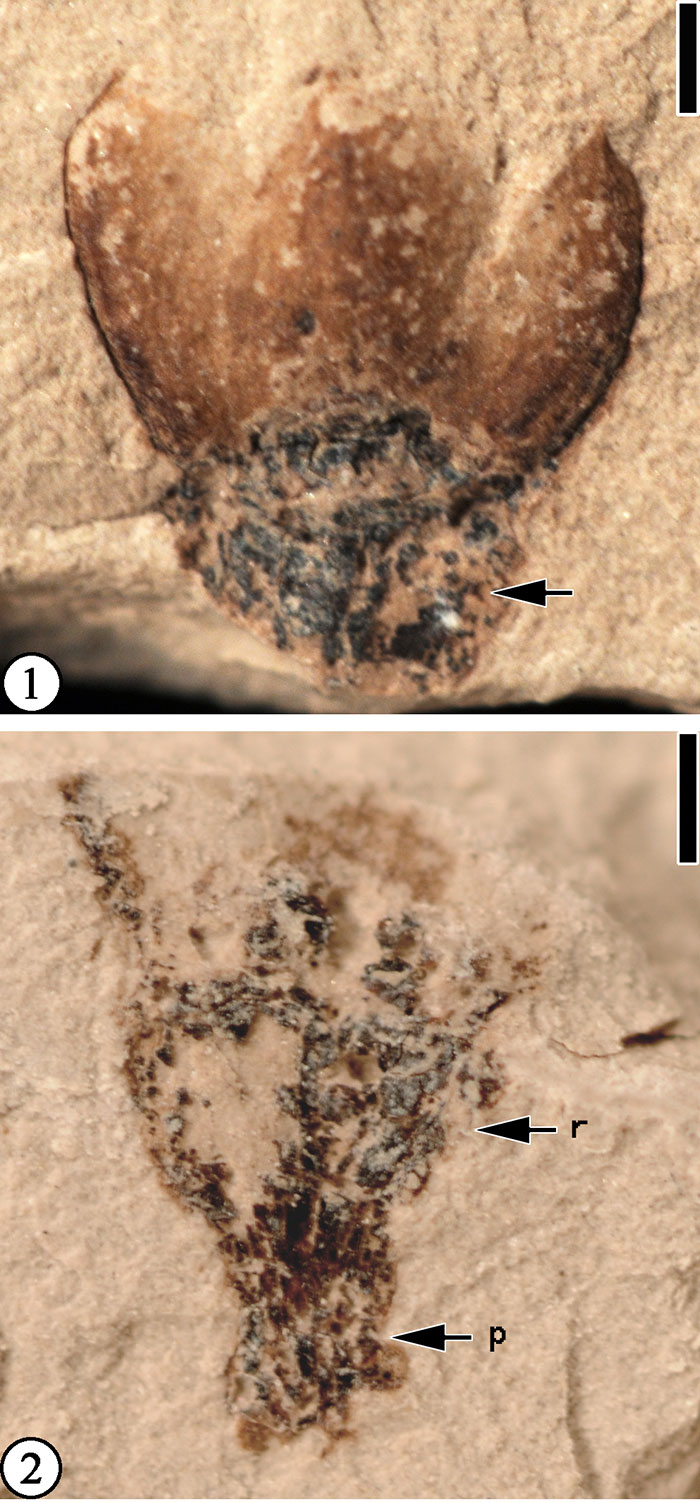
FIGURE 37. Claiborne Floral Type 16: 1) UF15737-059226. Showing at least 18 scattered florets (arrows) compressed with an unknown floral structure. Scale bar equals 2mm; 2) Enlargement of Figure 37.1 (indicated by right arrow) to show an individual flower. Scale bar equals 0.5 mm; 3) Enlargement of Figure 37.1 (indicated by bottom arrow) to show a flower with inferior ovary and three perianth parts. Scale bar equals 0.5 mm; 4) Enlargement of Figure 37.1 (indicated by top arrow) to show a stigmatic disc. Scale bar equals 0.5 mm; 5) Enlargement of Figure 37.1 (indicated by left arrow) to show pedicel and three perianth parts. Scale bar equals 5 mm; 6-7) UF15737-059317, 059317'. Part and counterpart of a specimen showing two perianth parts, style and stigmatic disc, ovary, and pedicel. Scale bar equals 0.5 mm.
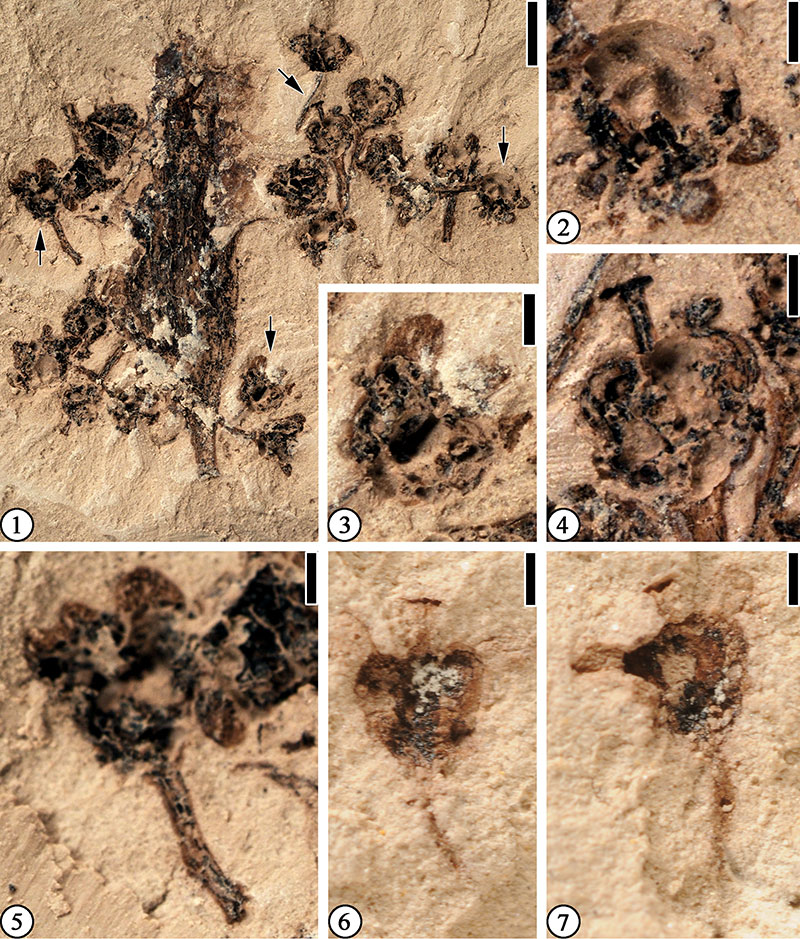
FIGURE 38. Claiborne Floral Type 17: 1) UF15738-060634. Laterally preserved flower showing a sepal with a prominent midvein (indicated by arrow) and numerous filaments. Scale bar equals 2 mm; 2) UF15738-060634’. Counterpart of Figure 38.1 showing a petal (indicated by arrow). Scale bar equals 2 mm.
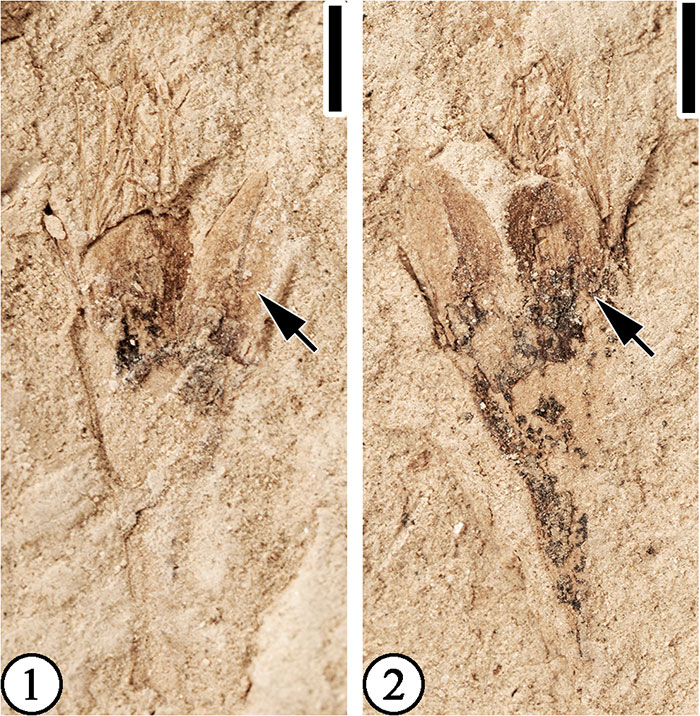
FIGURE 39. Claiborne Floral Type 18. All Scale bar equal 1 mm: 1) UF15737-059241’a. Counterpart of a laterally preserved flower showing a short pedicel (p), fused filaments (f), anthers (a), and a perianth part (pp); 2) UF15737-059241a. Part of Figure 39.1 showing a filament spliting from the column (indicated by arrow); 3) UF15735-059323. Two laterally preserved flowers. Note strong connectives of the anthers (indicated by arrows).
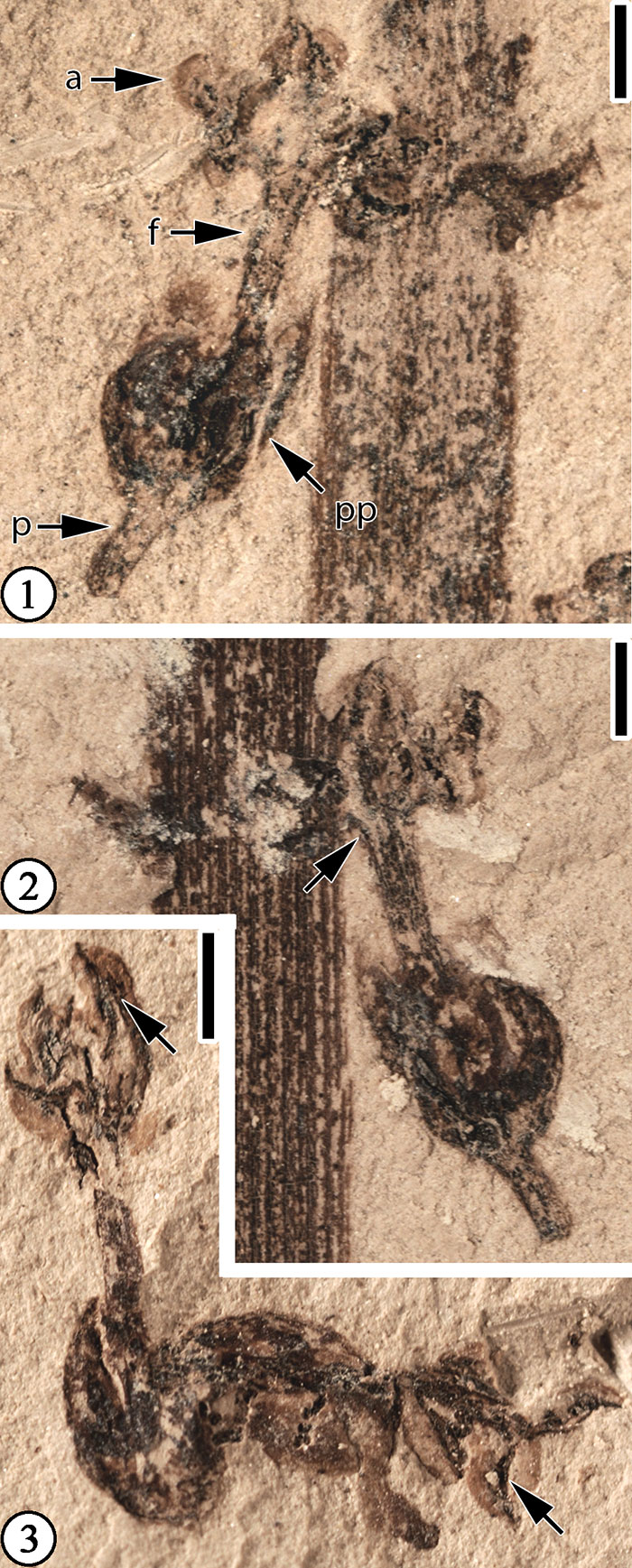
FIGURE 40. Claiborne Floral Type 19 (1-2), UF15737-059316, 059316'. Part and counterpart of a specimen showing midvein and lateral veins. Scale bar equals 0.5 mm.

FIGURE 41. Claiborne Floral Type 20: 1) UF15737-059209. Showing stamen mass. Note distinct filament zone (indicated by arrow) and anther zone above. Scale bar equals 1 mm; 2) Enlargement of Figure 41.1 to show suborbiculate anthers. Scale bar equals 0.5 mm.
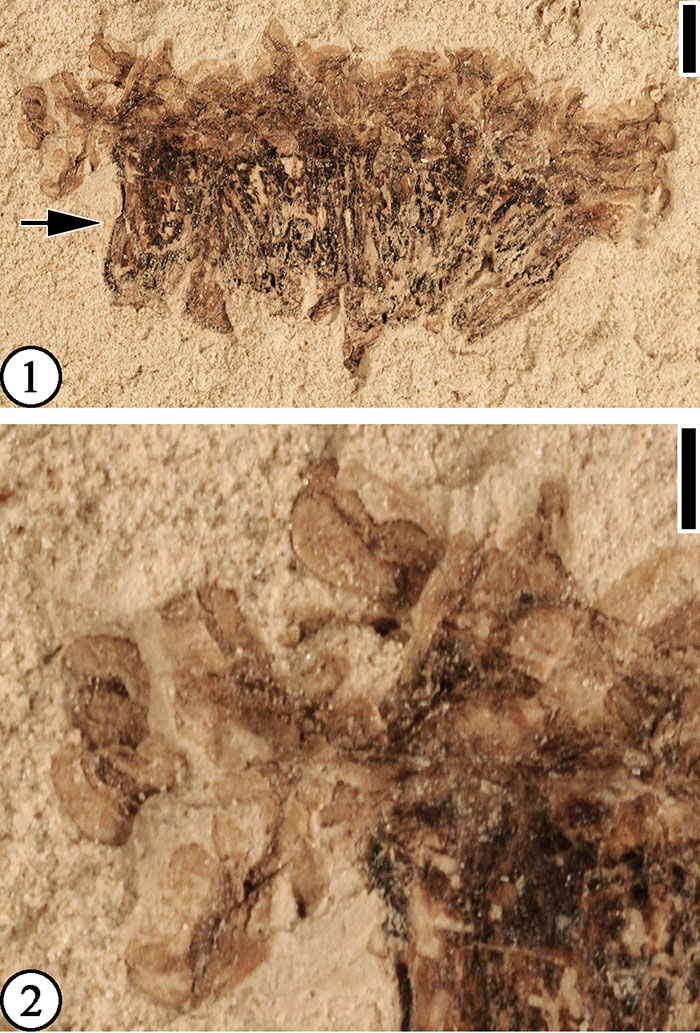
FIGURE 42. "Sparganium" sp. : 1-2), UF15737-027592, 027592'. Part and counterpart of a specimen showing an infructescence with a stout stalk. Scale bar equals 2 mm; 3) Enlargement of Figure 42.2 to show small fruits. Scale bar equals 0.5 mm.
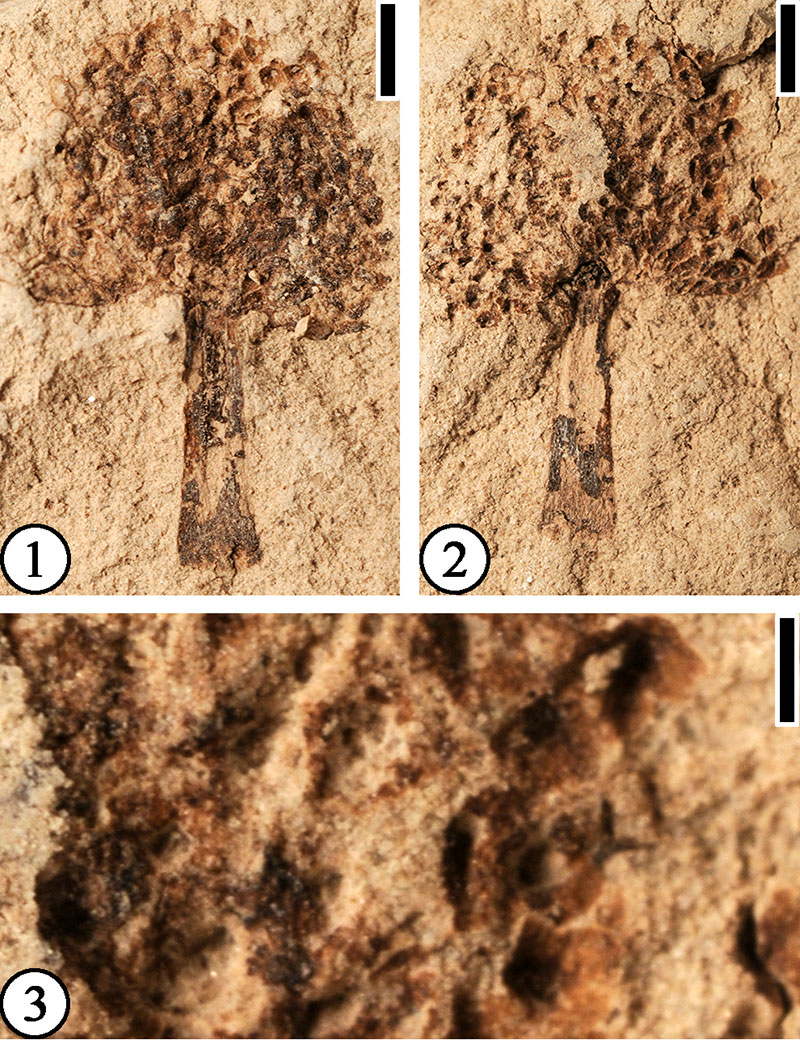
FIGURE 43. Claiborne Infructescence Type 4 (1-2), UF15737-059313, 059313'. Part and counterpart of specimen showing an infructescence with sessile fruits (f) attached to the axils of bracts (b). Scale bar equals 3 mm.
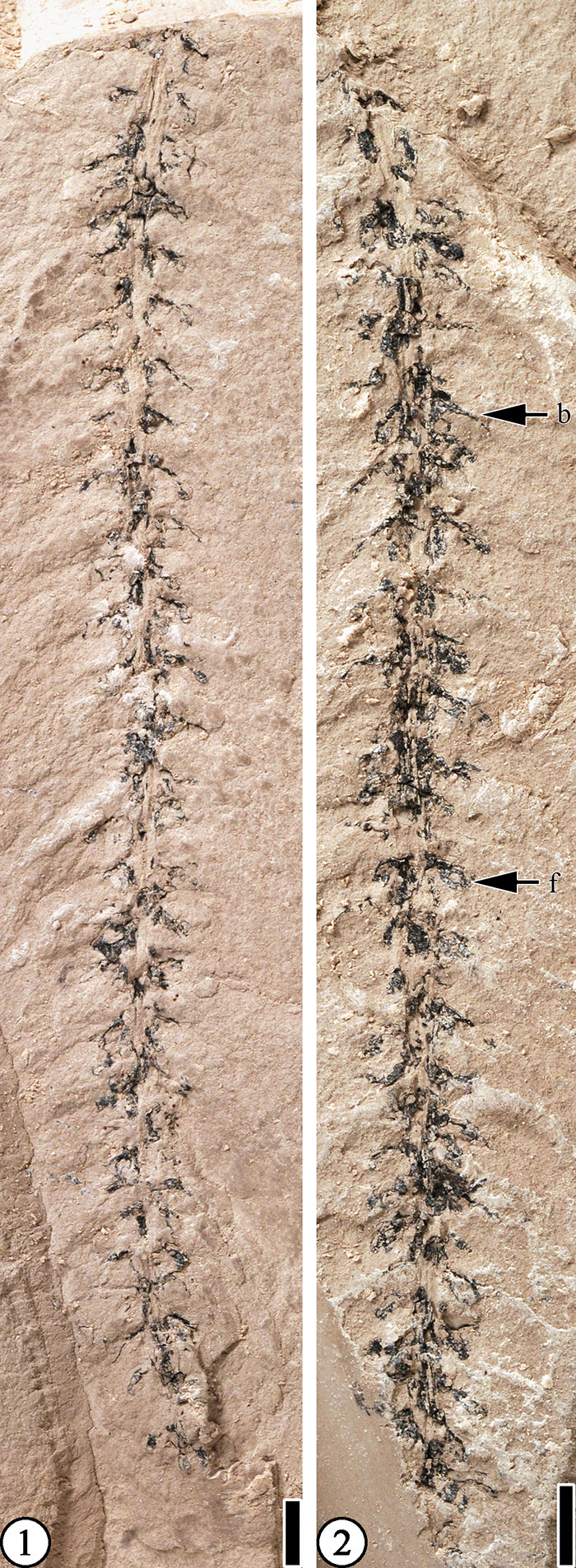
FIGURE 44. Claiborne Infructescence Type 5: 1) UF15737-059250. An infructescence with seven winged fruits (f), a receptacle (r), and a peduncle (p). Scale bar equals 1 mm; 2) UF15737-059234. Showing an infructescence with at least five fruits. Scale bar equals 0.5 mm.
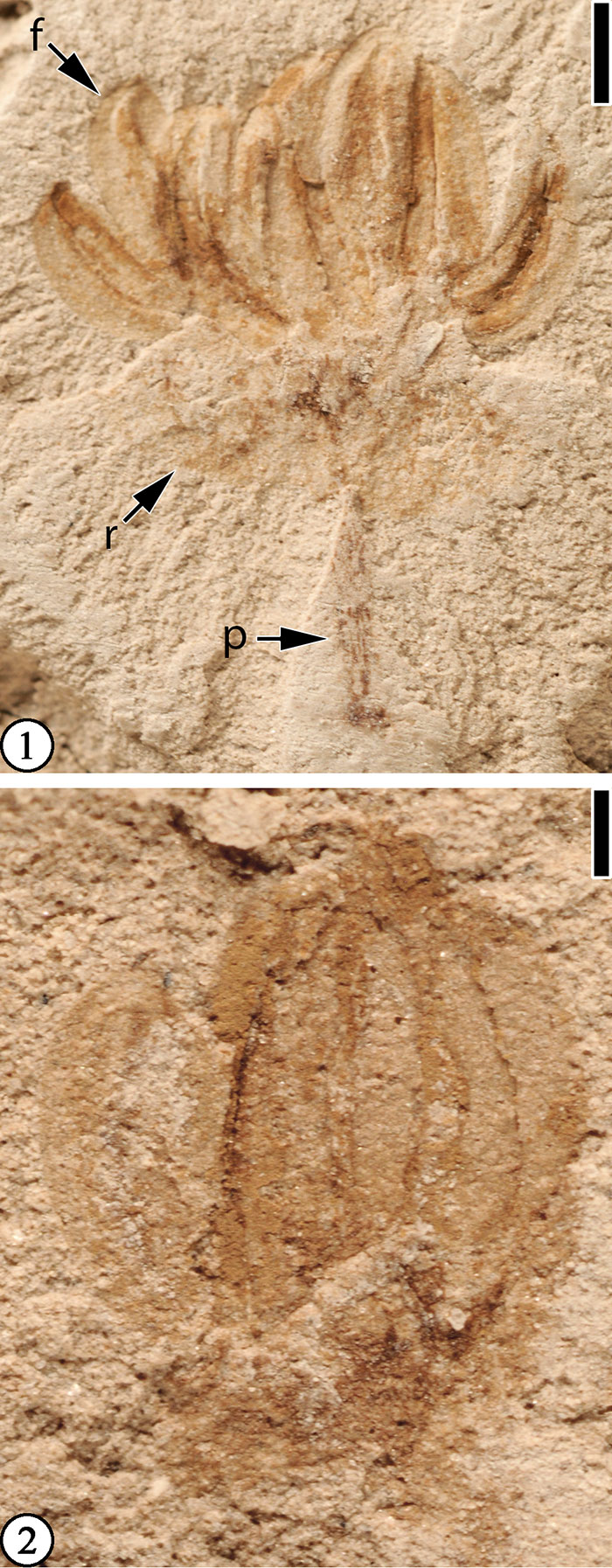
FIGURE 45. Claiborne Infructescence Type 6: 1) UF15737-059315. Showing laterally compressed infructescence with an incomplete peduncle. Note the presence of persistent perianth parts (indicated by white arrows) and pedicels on individual fruit (indicated by black arrows). Scale bar equals 1 mm; 2) Enlargement of Figure 45.1 to show trichome bases on peduncle. Scale bar equals 0.5 mm.
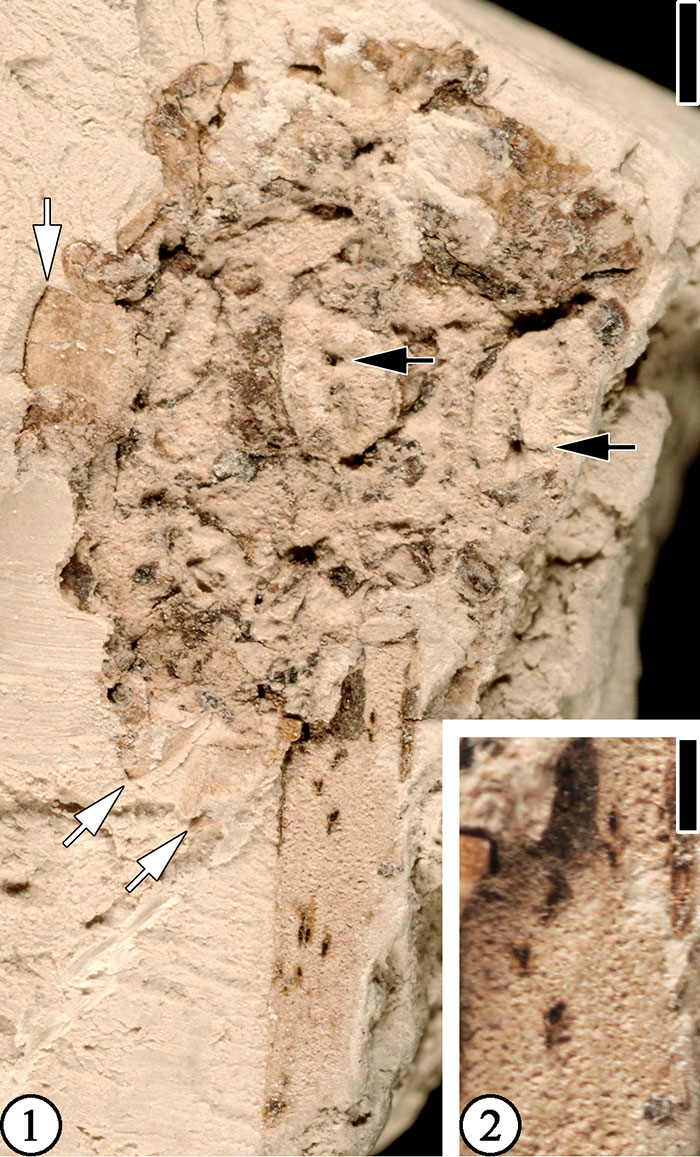
FIGURE 46. Claiborne Infructescence Type 8: 1) UF15738-060633. Showing a main axis with two lateral branches and a fruit. Scale bar equals 2 mm; 2) Enlargement of Figure 46.1 showing impressions of at least 4 seeds attached to a central point. Scale bar equals 1 mm.
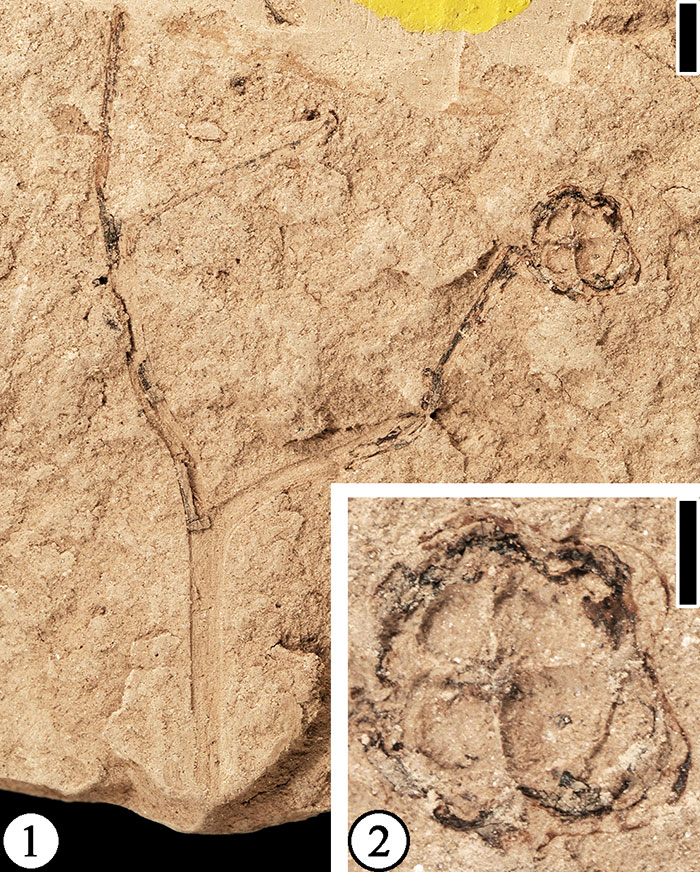
FIGURE 47. Carpolithus boldensis sp. nov.: 1) UF15738-059413. Specimen showing lemma (l), awn (a), and seed body (s). Scale bar equals 1 mm; 2) Enlargement of Figure 47.1 to show midvein of lemma (indicated by arrow) and narrow, elliptic seed body. Sclae bar = 0.5 mm.
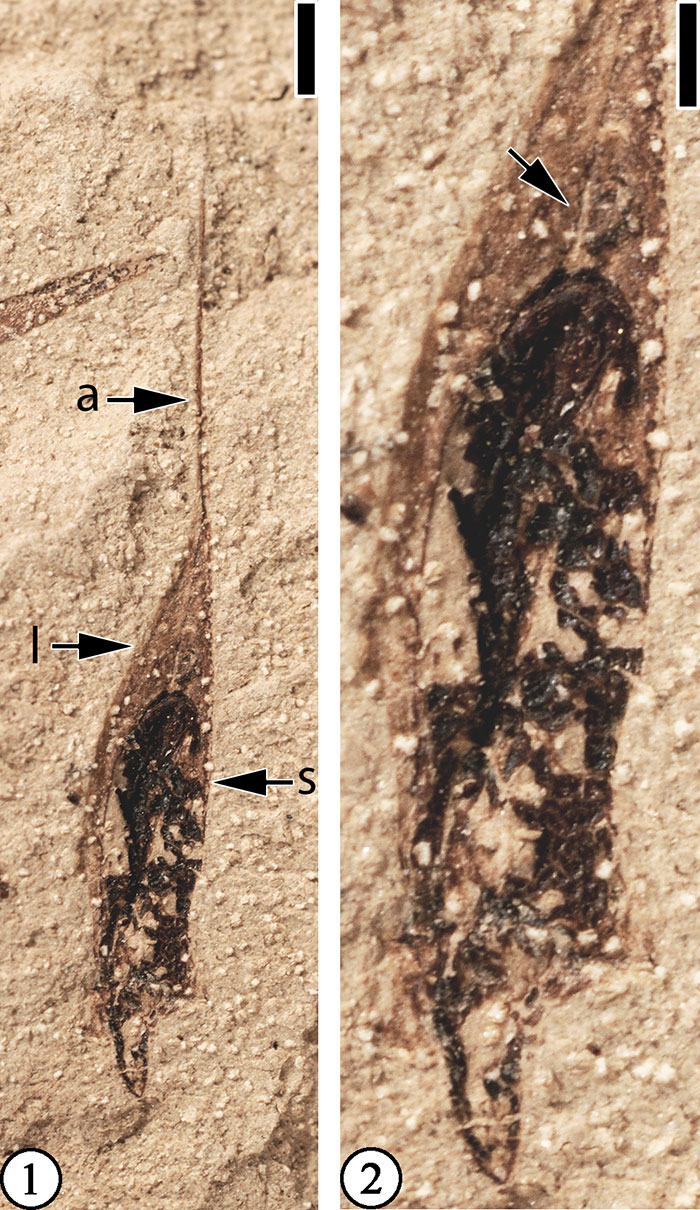
FIGURE 48. cf. Saportaspermum sp. (1-2), UF15737-059314, 059314'. Part and counterpart of specimen showing circular seed body and veinless wing. Note radial striations on the seed body. Scale bar equals 5 mm.
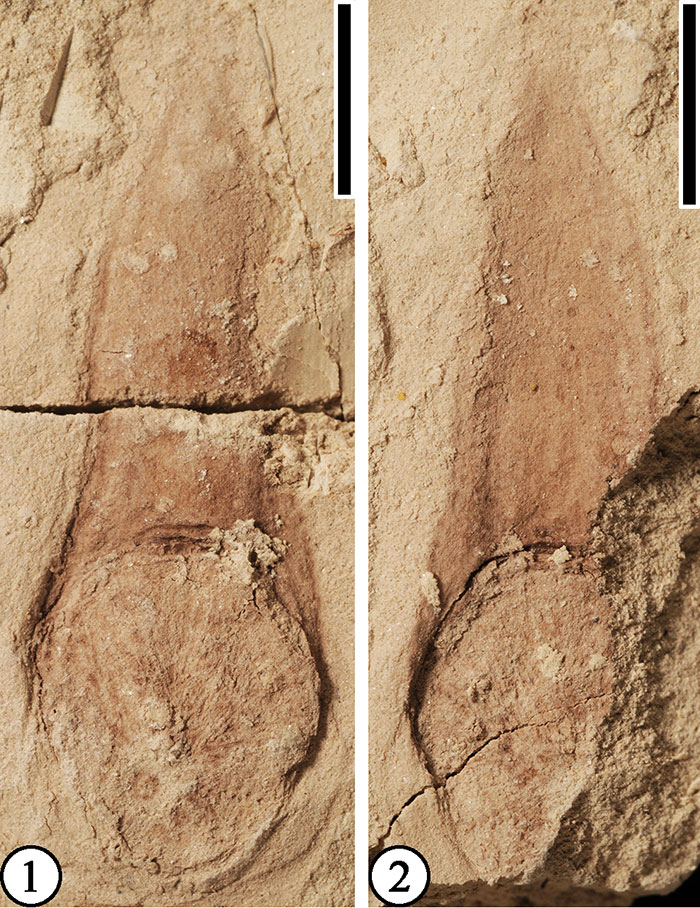
FIGURE 49. “Acer” knowltoni (Berry) Brown, 1940: 1-2) UF15737-059223, 059223'. Part and counterpart showing a samara. Note the protrusion with fibrous tip (indicated by arrow). Scale bar equals 2 mm; 3) A specimen from the Bolden clay pit, stored at the Paleobotany Collection at the Field Museum of Natural History, showing a samara and its venation. Scale bar equals 3 mm; 4) Enlargement of Figure 49.3 to show the smooth curvature of the inner margin of the base of the samara (indicated by arrow) and the seed outline. Scale bar equals 1 mm.
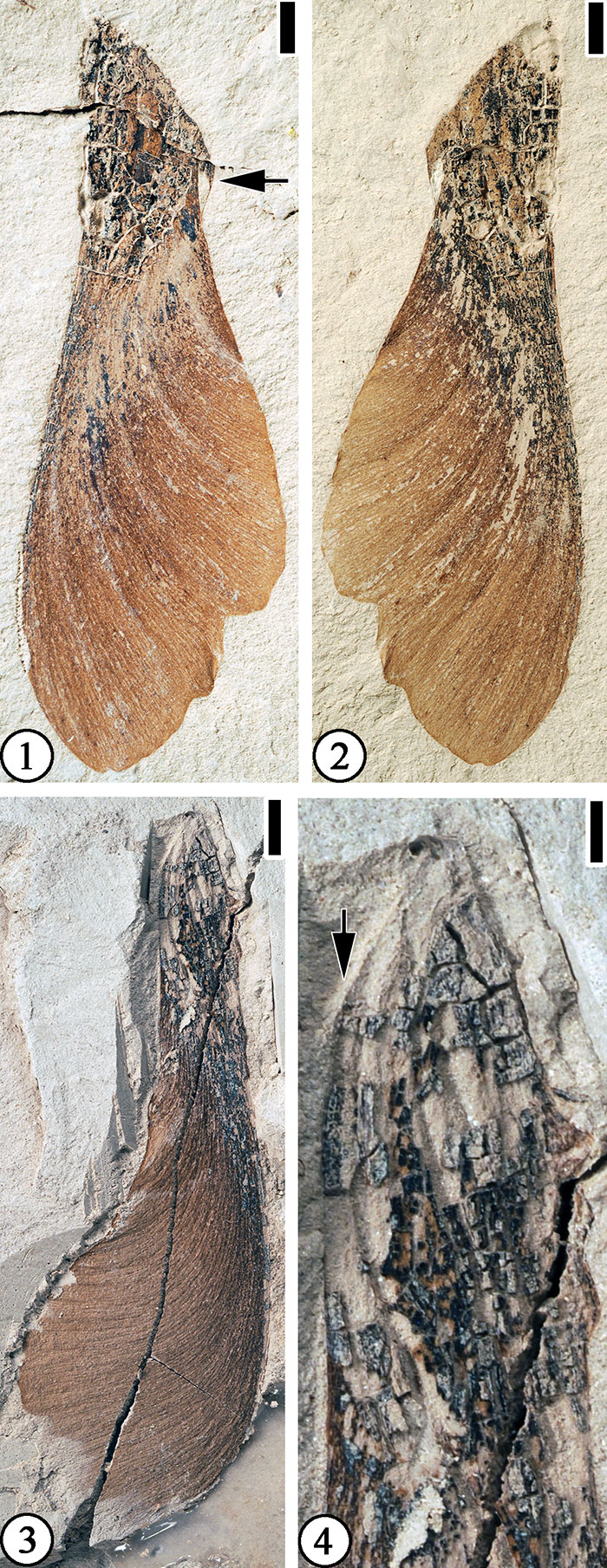
FIGURE 50. Claiborne Fruit/Seed Type 6: 1-2) UF15737-059237, 059237'. Part and counterpart of a specimen showing a spherical fruit/seed. Note fibers on the surface (indicated by arrows). Scale bar equals 1 mm; 3) UF15737-059242. Showing a spherical fruit/seed. Scale bar equals 1 mm; 4) Enlargement of Figure 50.3 (indicated by arrow) to show fibers associated with the fruit/seed. Scale bar equals 0.5 mm; 5) Enlargement of Figure 50.2 (indicated by arrow) to show fibers associated with the fruit/seed. Scale bar equals 0.5 mm.
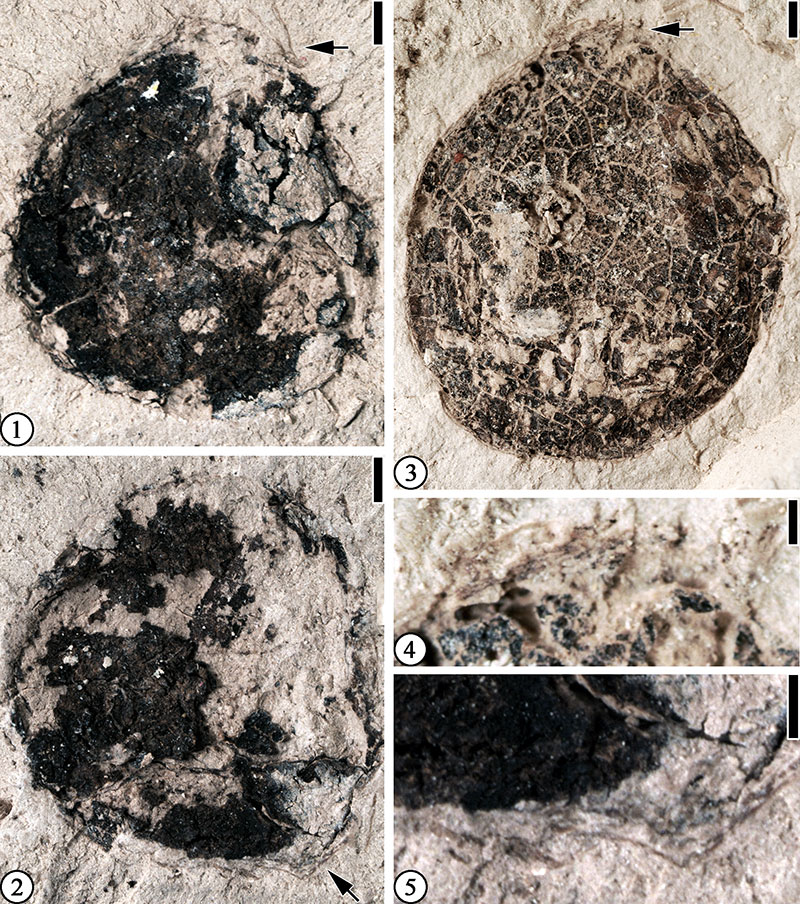
FIGURE 51. Claiborne Fruit/Seed Type 7 (1-2), UF15837-059319. Showing two possible orientations of a disseminule. It may represent a fruit with a persistent style (indicated by arrow) as in Figure 51.1 or a fruit with a pedicel (indicated by arrow) in Figure 51.2. Scale bar equals 0.5 mm.
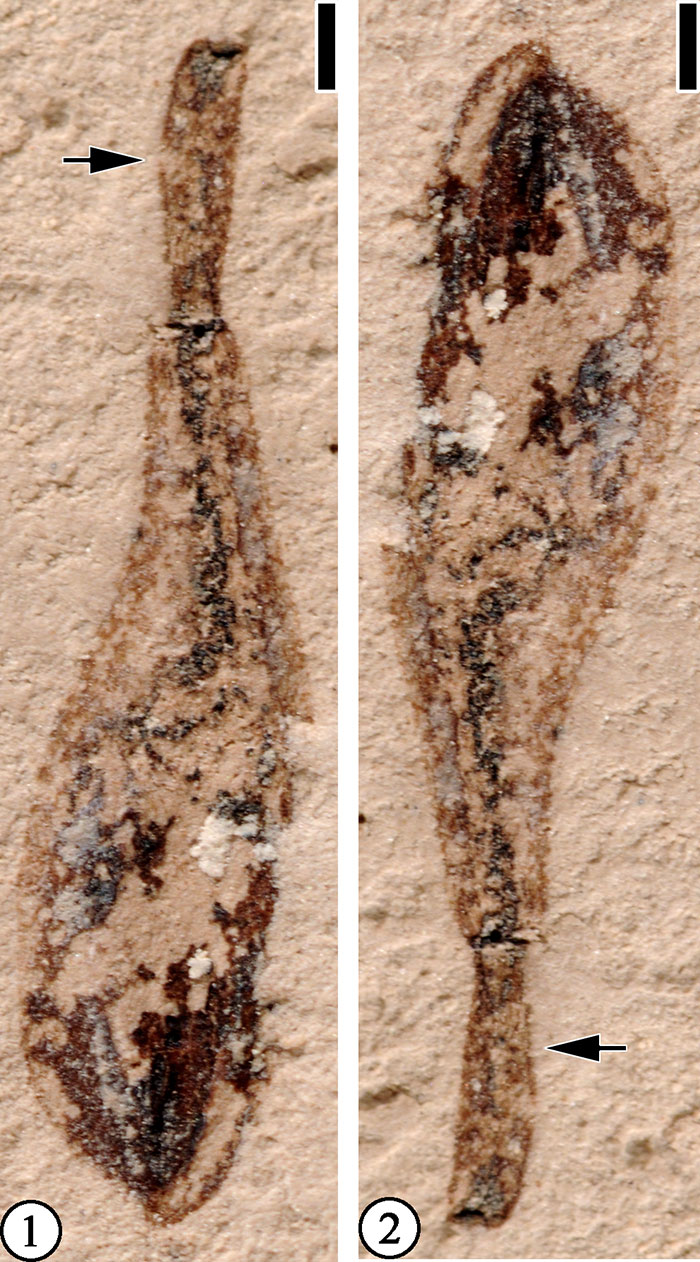
FIGURE 52. Claiborne Fruit/Seed Type 8 (1-2), UF15737-059245, 059245’. Part and counterpart of a specimen showing compressed ovoid sclerotesta with smooth surface and membranous endotesta (indicated by arrow in Figure 52.2). Scale bar equals 1 mm.
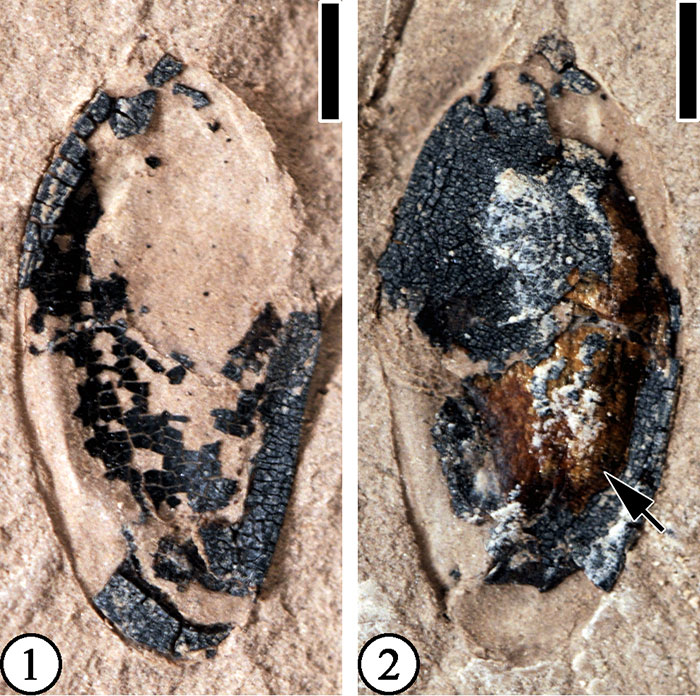
FIGURE 53. Claiborne Fruit/Seed Type 9 (1-2), UF15737-059324, 059324'. Part and counterpart of a specimen showing elliptical fruit/seed with longitudinal striations. Scale bar equals 1 mm.
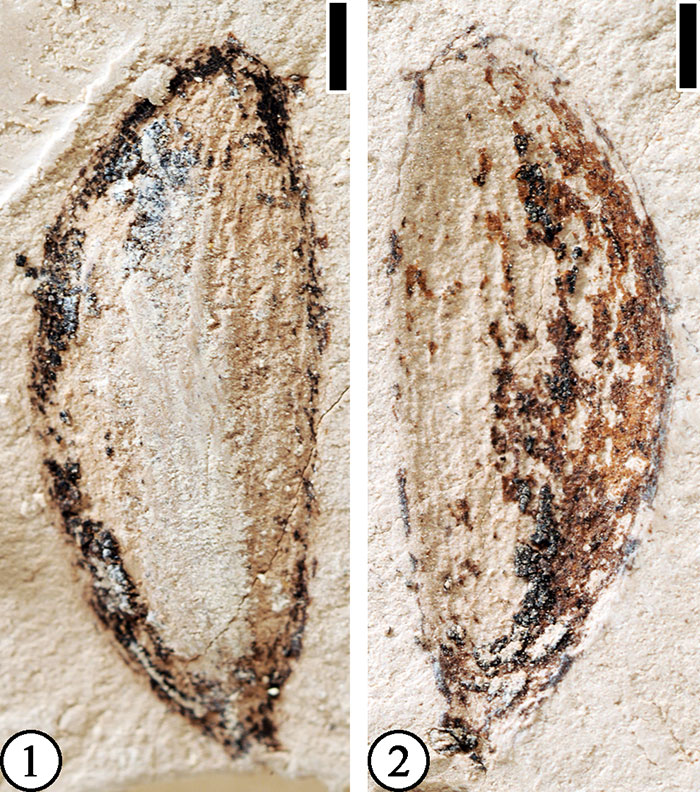
FIGURE 54. Claiborne Fruit/Seed Type 10 (1-2), UF15737-059228, 059228’. Part and counterpart of a specimen showing thin layer of tissue (indicated by white arrow) and hilum scar (at the bottom of seed as indicated by black arrows). Scale bar equals 0.5 mm.
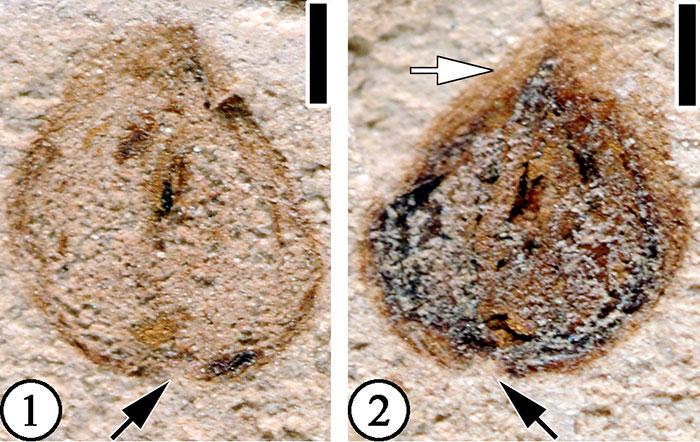
FIGURE 55. Palmocarpon wilcoxiana (Berry) Wang et al., 2013: 1-2) UF15737-008221, 008221'. Part and counterpart of a specimen showing elliptic endocarp and fiber strands (indicated by arrow). Scale bar equals 2 mm; 3) UF15737-059231. Specimen showing elliptic endocarp. Note fine fiber strands at the distal end (indicated by arrow). Scale bar equals 2 mm; 4) UF15737-059243a. Specimen showing fiber strands/projections at the distal end (indicated by arrow). Scale bar equals 2 mm.
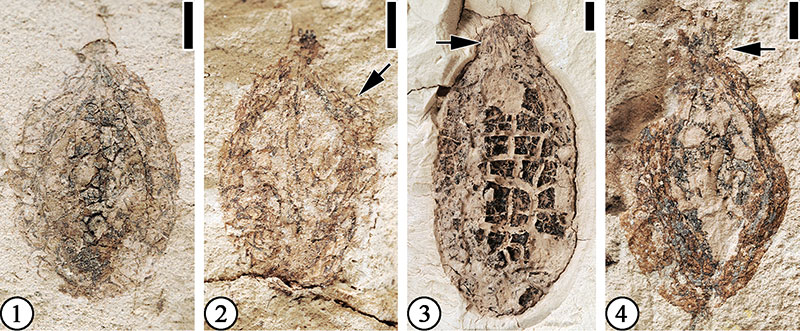
FIGURE 56. Claiborne Undetermined Structure 1 (1-2), UF15737-059229, 059229'. Specimen showing a median ridge on part and a median groove on the counterpart. Scale bar equals 1 mm.

FIGURE 57. Claiborne Undetermined Structure 2, UF15737-059297. Specimen showing a symmetric structure with a central groove. Scale bar equals 2 mm.
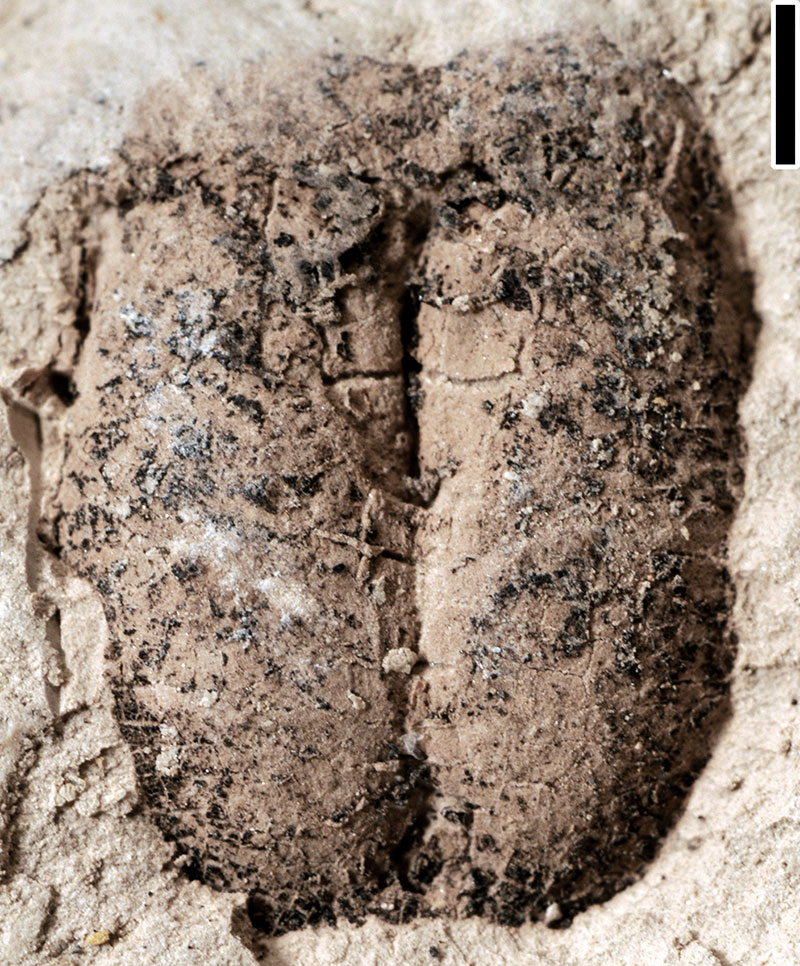
FIGURE 58. Claiborne Undetermined Structure 3, UF15737-059244. Specimen showing linear, basally fused units encircling a central area. Note that the apices of the linear units (indicated by arrows) are curved into the matrix. Scale bar equals 1 mm.

FIGURE 59. Claiborne Undetermined Structure 4, UF15737-008228. Specimen showing scale-like, irregular hexagonal surface pattern of the structure. Scale bar equals 0.25 mm.
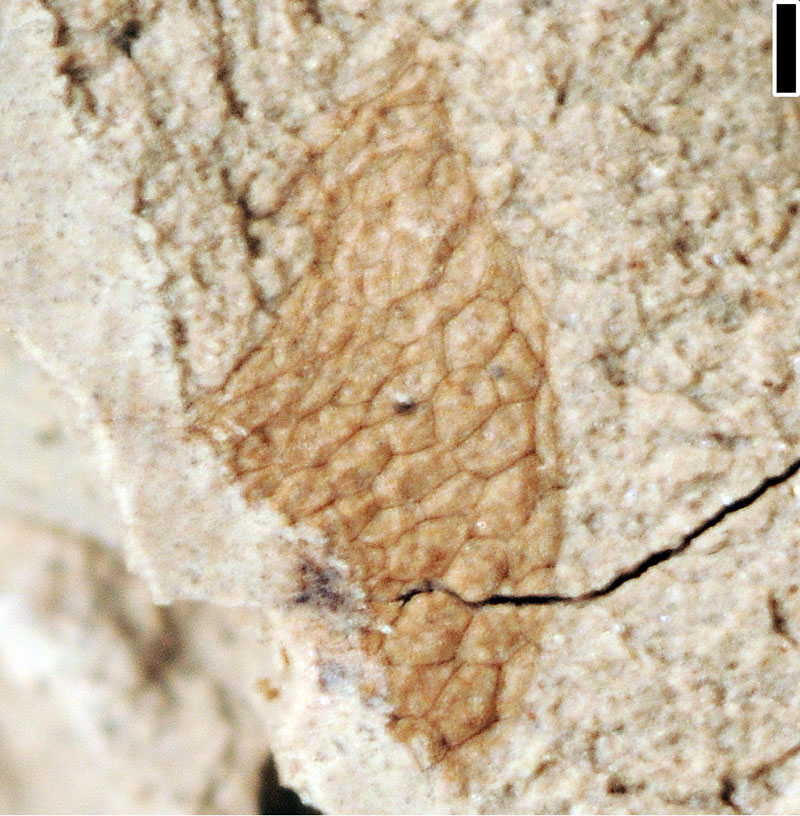
FIGURE 60. Salvinia preauriculata Berry, 1930; UF15737-030658. Specimen showing two floating fronds and a finely dissected, rootlike submerged frond. Scale bar equals 1 mm.
